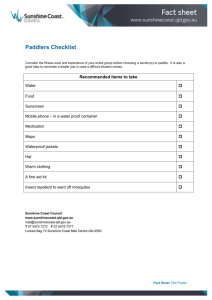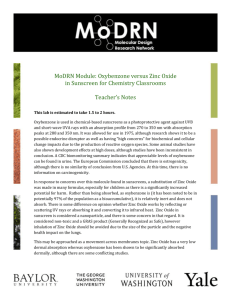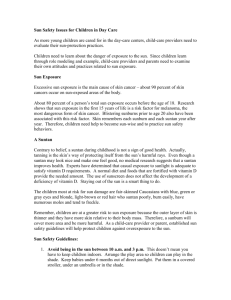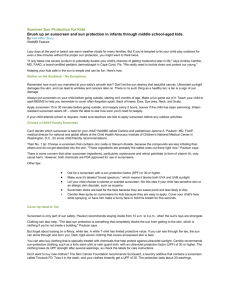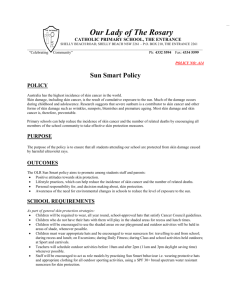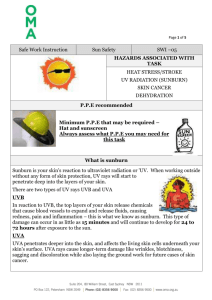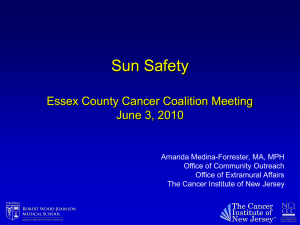WORD - Molecular Design Research Network (MoDRN)
advertisement
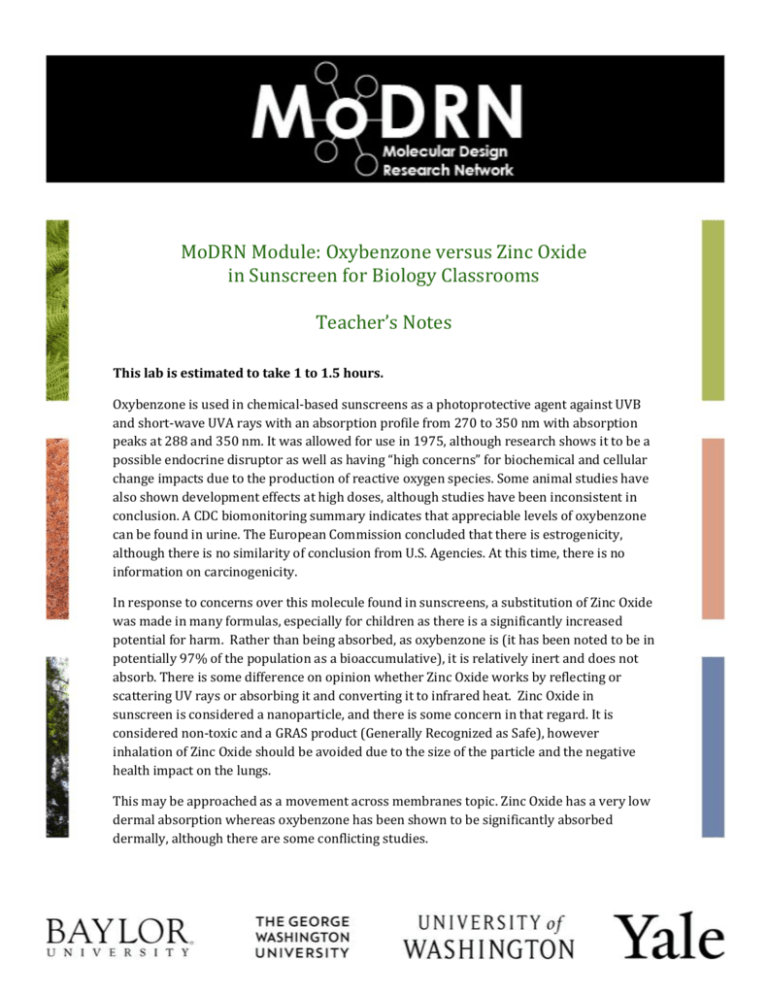
MoDRN Module: Oxybenzone versus Zinc Oxide in Sunscreen for Biology Classrooms Teacher’s Notes This lab is estimated to take 1 to 1.5 hours. Oxybenzone is used in chemical-based sunscreens as a photoprotective agent against UVB and short-wave UVA rays with an absorption profile from 270 to 350 nm with absorption peaks at 288 and 350 nm. It was allowed for use in 1975, although research shows it to be a possible endocrine disruptor as well as having “high concerns” for biochemical and cellular change impacts due to the production of reactive oxygen species. Some animal studies have also shown development effects at high doses, although studies have been inconsistent in conclusion. A CDC biomonitoring summary indicates that appreciable levels of oxybenzone can be found in urine. The European Commission concluded that there is estrogenicity, although there is no similarity of conclusion from U.S. Agencies. At this time, there is no information on carcinogenicity. In response to concerns over this molecule found in sunscreens, a substitution of Zinc Oxide was made in many formulas, especially for children as there is a significantly increased potential for harm. Rather than being absorbed, as oxybenzone is (it has been noted to be in potentially 97% of the population as a bioaccumulative), it is relatively inert and does not absorb. There is some difference on opinion whether Zinc Oxide works by reflecting or scattering UV rays or absorbing it and converting it to infrared heat. Zinc Oxide in sunscreen is considered a nanoparticle, and there is some concern in that regard. It is considered non-toxic and a GRAS product (Generally Recognized as Safe), however inhalation of Zinc Oxide should be avoided due to the size of the particle and the negative health impact on the lungs. This may be approached as a movement across membranes topic. Zinc Oxide has a very low dermal absorption whereas oxybenzone has been shown to be significantly absorbed dermally, although there are some conflicting studies. The chemistry classroom module aligns to the following Next Generation Science Standard: HS-PS2-6. Communicate scientific and technical information about why the molecular-level structure is important in the functioning of designed materials. The biology classroom module aligns to the following Next Generation Science Standard: HS-ETS1-2. Design a solution to a complex real-world problem by breaking it down into smaller, more manageable problems that can be solved through engineering. The environmental science classroom module aligns to the following Next Generation Science Standard: HS-LS4-6. Create or revise a simulation to test a solution to mitigate adverse impacts of human activity on biodiversity. NOTE: The experiment for the environmental science classroom can be adapted uses other organisms or seeds. Supplemental Readings The following are supplemental readings for you and your students to understand the general principles of green chemistry as well as the role of molecule substitution in toxicity consideration: CDC. (2013). Oxybenzone: Biomonitoring Summary. Retrieved from http://www.cdc.gov/biomonitoring/Benzophenone-3_BiomonitoringSummary.html European Commission. (2001). Opinion on the Evaluation of Potentially Estrogenic Effects of UV-filters adopted by the SCCNFP during the 17th Plenary meeting of 12 June 2001. Retrieved from http://ec.europa.eu/health/scientific_committees/consumer_safety/opinions/sccnfp_opini ons_97_04/sccp_out145_en.htm European Commission. (2006). Opinion on Benzophenone-3. Retrieved from http://ec.europa.eu/health/ph_risk/committees/04_sccp/docs/sccp_o_078.pdf Environmental Working Group. (2014). Oxybenzone. Retrieved from http://www.ewg.org/skindeep/ingredient/704372/OXYBENZONE/# NCBI. (n.d.). PubChem compound: Oxybenzone. Retrieved from http://pubchem.ncbi.nlm.nih.gov/summary/summary.cgi?cid=4632 U.S. Department of Health and Human Services. (2015). Toxicology tutorials. Retrieved from http://sis.nlm.nih.gov/enviro/toxtutor.html Background What is UV? UV is ultraviolet light, a light wave shorter than violet-color light. UV light is divided into 3 wave-lengths: UV-A, the most common; UV-B, the most dangerous; and UV-C , is dangerous but we’re not exposed because it is bounced back to space by the Earth’s ozone layer. THE LIGHT SPECTRUM Infrared Visible UV-A UV-B UV-C 1000-700nm* 390-700nm* 400-315nm* 315-280nm* 280-100nm* Makes our skin feel warm. Can be seen by snakes Wavelength seen by our eyes. Includes the colors of the visible spectrum Invisible. Shorter wavelengths, more energy. Causes skin damage, premature aging, melanoma. Passes through car glass Causes sunburn, skin cancer, photo-aging, cataracts. Needed for Vitamin D synthesis Dangerous, but completely absorbed by the ozone layer and doesn’t reach earth surface What does Exposure mean? Exposure happens when UV radiation from the sun reaches your skin. You are exposed to UV when you are outside on sunny or cloudy days. UV intensity varies with time of day, season, and latitude. The equator at noon receives much more UV than at noon in Norway. You can still get sunburned on cloudy days because UV rays can bounce off the clouds. This is known as the broken-cloud effect. In fact, one survey found that UV-B increased by 25% on party cloudy compared to sunny days. Risks & Benefits of UV Exposure UV is an environmental carcinogen, which means that being exposed to UV light can cause cancer. Unprotected UV exposure causes skin damage, speeds aging and increases lifetime risk of skin cancer. Sun exposure also causes wrinkles, brown spots, leathering and sagging. There is no such thing as a healthy tan. Any change in your skin color is a sign of skin damage. 1.3 million people are diagnosed with skin cancer in the US each year, mostly from sun exposure. UV is harmful for anyone, but those with fair skin are at higher risk because they burn more quickly and severely. More Americans have skin cancer than all other cancers combined. The only benefit of UV exposure is Vitamin D. Five minutes of unprotected UV 2-3 times a week provides all the Vitamin D the body can make. Some UV reaches the skin even when you wear sunscreen. What is SPF? SPF stands for Sun Protection Factor. SPF is the fraction of UV-B rays blocked by the sunscreen. In SPF15, 1/15th of the UV-B rays will reach the skin when sunscreen is applied properly. If you get sunburned in 10 minutes without sunscreen, you will prevent sunburn for 150 minutes by wearing an SPF15 sunscreen. SPF15 sunscreen protects from 93% of UV-B, SPF30 protects from 97%, and SPF50 gives 98% protection. The Food and Drug Administration (FDA), which regulates sunscreens as an over-the-counter drug, does not recommend using sunscreen with SPF higher than 50. FDA says sunscreen higher than SPF50 is misleading because it offers little added protection, gives a false sense of safety, and tempts people to reapply less often or stay in the sun longer. What about nanoparticles in sunscreen? Nanoparticles are ultra-fine particles between 1-100 nanometers in diameter. Nano-size titanium dioxide and zinc oxide have been used in some sunscreens since the 1990s. These physical ingredients reflect, scatter and absorb UV rays and don’t tend to cause allergic reactions. The nano-size particles are clear, while older sunscreens used larger particles that appeared white on the skin. Nanoparticles do not pass through healthy skin. Sunscreen with nano-particles protects skin as soon as it is applied while conventional sunscreens must be absorbed. Risks & Benefits of Using Sunscreen Sunscreens are more protective against UV-B than UV-A. Avobenzone, titanium dioxide and zinc oxide protect against UV-A. New products that protect against UV-A are used in Europe and are under review by the FDA. Spray sunscreen should not be inhaled, especially sunscreen with nanoparticles because the small particles can be harmful to the lungs. Oxybenzone in sunscreen can penetrate the skin and cause an allergic reaction. It can also interfere with normal hormone function. Sunscreen SPFs higher than 50 have higher concentrations of chemicals and are more likely to have these effects. However, any sunscreen is better for you than being exposed to UV radiation. How Can I Protect Myself? Stay out of the sun between 10am-4pm Stay in the shade Wear protective clothing Use a “broad spectrum” sunscreen with SPF30-50 to protect from both UV-A and UV-B Avoid getting sunburned Apply sunscreen thickly, 1 oz. every 2 hours Apply conventional sunscreen 20 min. before going in the sun, giving it time to absorb into your skin Don’t use indoor tanning beds. Exposure to tanning beds before age 30 increases the risk of developing melanoma by 75% With less mature skin and higher surface area to body weight, babies should not be exposed to UV or sunscreen. Babies under 6 mo should be covered and kept out of the sun, especially from 10am-4pm Student Laboratory Experiment: Use of UV Beads to Determine Efficiency of Various Sunscreens Student Learning Objectives At the end of this lesson, students will be able to: Predict the differences between the various SPF levels Understand health differences between zinc oxide and oxybenzone Recognize the safety issues associated with UV, tanning, and sun exposure See the absorption potential of various sunscreen SPFs. Materials 3 Black Lights. Long fluorescent lights and fluorescent black light bulbs 2 x 4’s to create base for UV light (option: use sunlight instead of black lights) Lotion and 3 sunscreens, SPF 15, 30, and 50, but not higher than 50 Clear, glow-in-the-dark clear UV beads, Small clear containers Small piece of black poster board Fine point dry erase marker Student Worksheet/Recording Sheet Teacher kit contains materials packaged for 13 student groups Lab Safety Always remember to follow the posted lab safety and waste disposal instructions. Please visit the American Chemical Society for Safety Guidelines. http://www.acs.org/content/acs/en/education/policies/safety.html Real World Application When choosing products such as sunscreen, deodorant, cleaners, hair products, shampoo, etc, it is important to read the label and research a little into the ingredients to learn more about potential impact on your health. As this activity shows, there may be safer alternatives that allow you to be in control of your health by choosing these alternatives. Pre-Lab Questions How will you know whether or not the UV beads have been exposed to UV radiation? _________________________________________________________________________________________________________ _________________________________________________________________________________________________________ _________________________________________________________________________________________________________ _________________________________________________________________________________________________________ What do you expect to see in each box after you place it under the black light or in the sun? Fill in the grid below with your predictions: Box # Lotion type: Prediction: Box 1 Box 2 Box 3 Box 4 Box 5 Explain your predictions _________________________________________________________________________________________________________ _________________________________________________________________________________________________________ _________________________________________________________________________________________________________ _________________________________________________________________________________________________________ Method and Instructions 1. Gather your materials to begin the experiment: UV beads in plastic boxes, dry erase marker, black poster board, and a black light (or experiment can be done near a window or outside). 2. The beads in the boxes change color in UV light. The objective is to see whether and how effectively lotion and various SPFs prevent the UV beads from being exposed to UV light. 3. Apply lotion and the various sunscreen SPFs to the lid of the boxes, to simulate sunscreen on the skin. Use as much as you would when applying on your own skin. Each lid should have an equal amount of lotion. 4. Use the marker to label the boxes, to keep track of what substance you apply to each box: Control (nothing is applied to the control box). Lotion SPF 15 SPF 30 SPF 50 5. Place the 5 plastic boxes on the black poster board. It would be helpful to place them in the order of the bullets above. Places your poster board under the black light for approximately 1 minute. Notice how the beads change colors. 6. Remove the cardboard from the UV light and quickly turn the boxes over to view the beads through the clear surface (no lotion or sunscreen on that surface). Observe the color variation through the bottom of the box. Do it quickly as the color fades in a few seconds. Make note of the colors in your lab notebook or on a piece of paper. 7. Clean up your station, rinse the lotion and sunscreen from the lids of the boxes and dry, and return all materials to the front of the class where you got them. 8. Record your observations on this grid: Box # Lotion type: Prediction: Box 1 Box 2 Box 3 Box 4 Box 5 Laboratory Questions Does the sunscreen SPF make a difference for how much UV radiation exposure the beads receive? _________________________________________________________________________________________________________ _________________________________________________________________________________________________________ _________________________________________________________________________________________________________ _________________________________________________________________________________________________________ What does this exercise with UV beads teach us about our skin’s exposure to UV radiation? _________________________________________________________________________________________________________ _________________________________________________________________________________________________________ _________________________________________________________________________________________________________ _________________________________________________________________________________________________________ Since sunburn is associated with skin cancer, how could you lower your risk of cancer caused by UV exposure from excessive sun? _________________________________________________________________________________________________________ _________________________________________________________________________________________________________ _________________________________________________________________________________________________________ _________________________________________________________________________________________________________ How will this activity/unit impact your choices and behaviors in regard to your health? _________________________________________________________________________________________________________ _________________________________________________________________________________________________________ _________________________________________________________________________________________________________ _________________________________________________________________________________________________________ Will you make a conscious decision to alter your purchases? Why or why not? _________________________________________________________________________________________________________ _________________________________________________________________________________________________________ _________________________________________________________________________________________________________ _________________________________________________________________________________________________________ Background Information originally created by participants in The Academy for Teaching about Health and Environment Interactions (ATHENA), a program of the University of Washington Center for Ecogenetics and Environmental Health. Funding from the National Institute of Environmental Health Sciences (NIEHS), Grant #ES007033.

